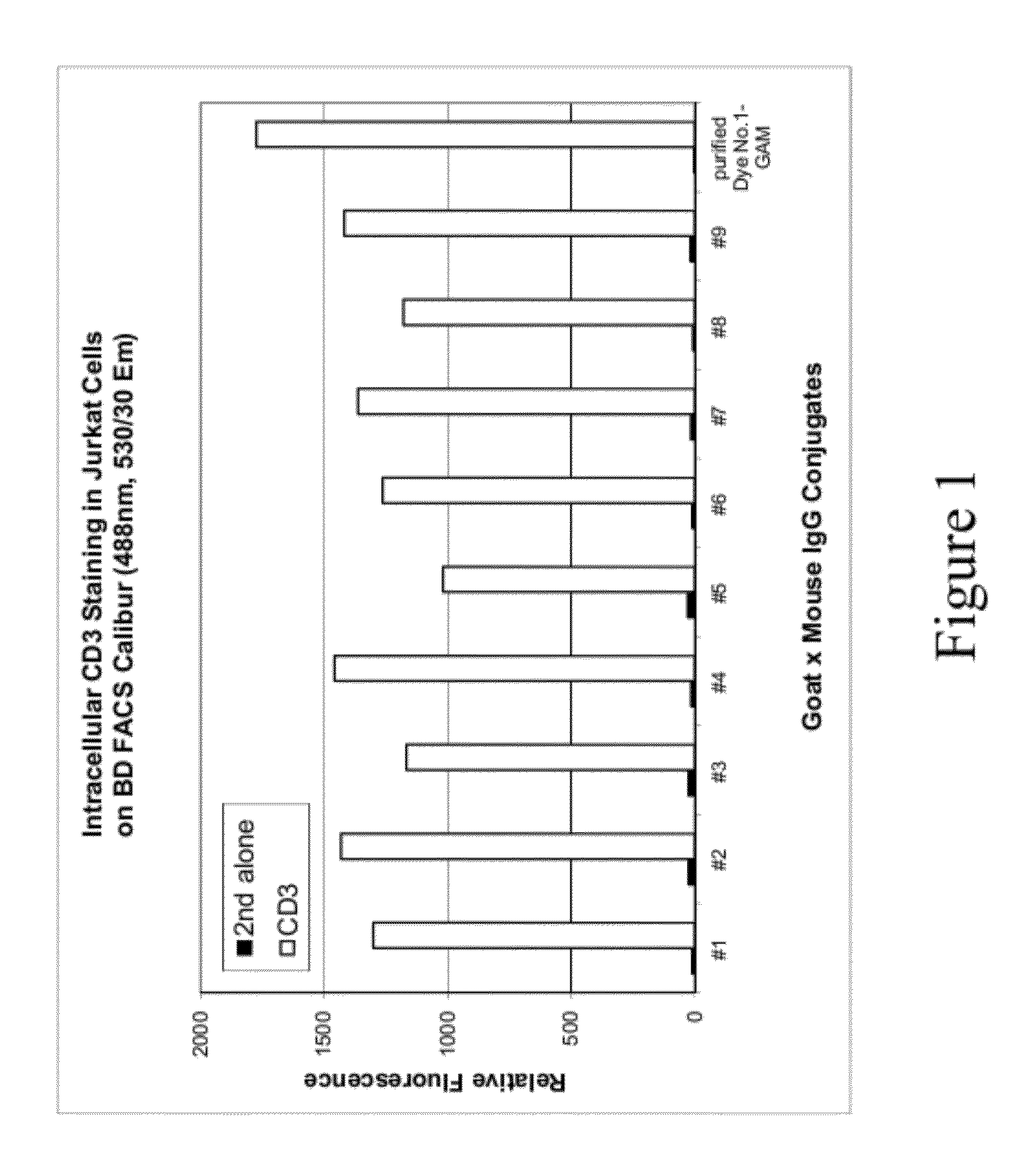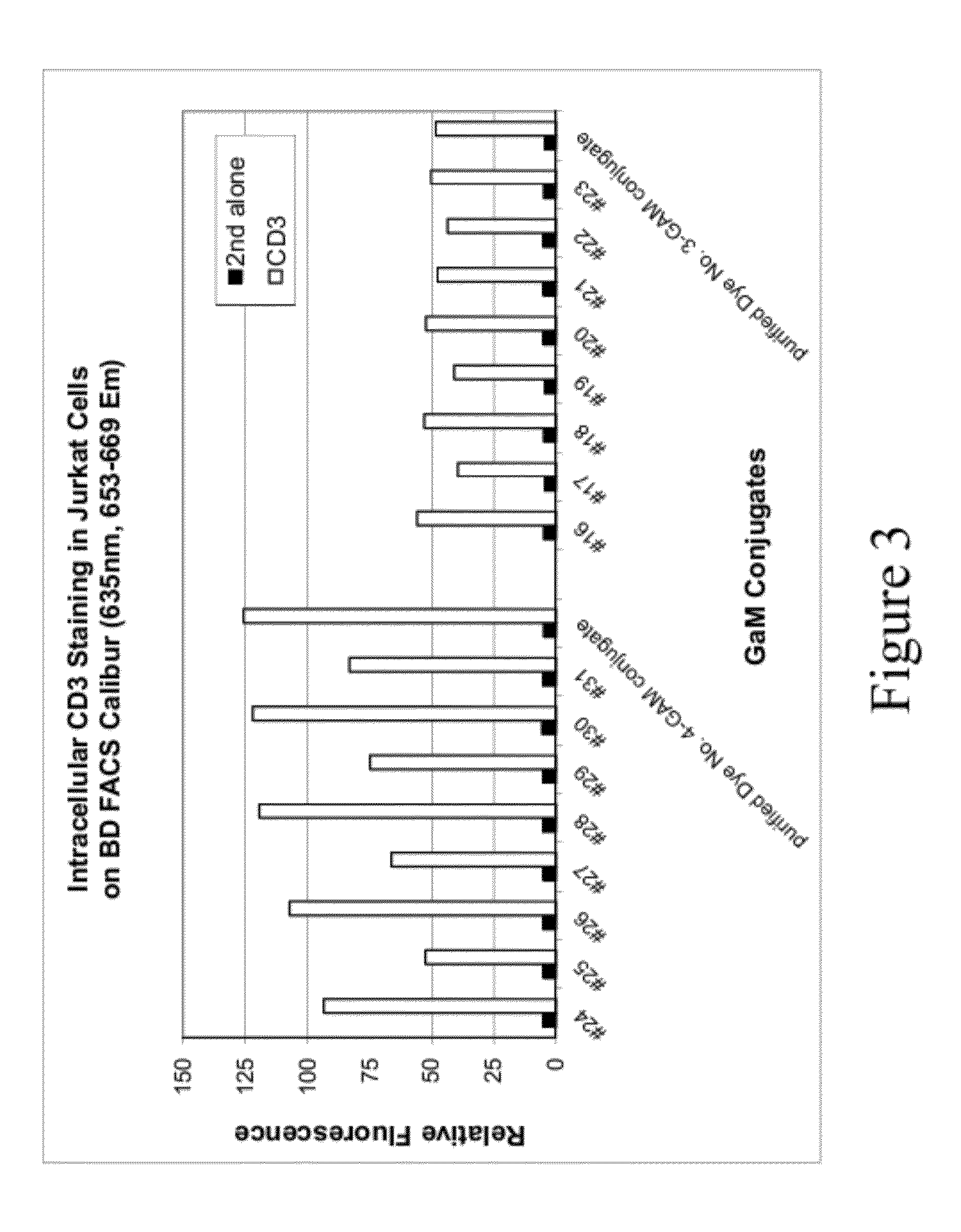Fluorescent dyes, fluorescent dye kits, and methods of preparing labeled molecules
a technology of fluorescent dye and labeled molecules, which is applied in the field of fluorescent dye kits and methods of preparing labeled molecules, can solve the problems of consuming valuable time and resources in current processes, and achieve the effect of enhancing dye fluorescen
- Summary
- Abstract
- Description
- Claims
- Application Information
AI Technical Summary
Benefits of technology
Problems solved by technology
Method used
Image
Examples
example 1
Analysis of Cells Stained with Secondary Antibody Labeled with Compound No. 126
[0111]This example describes the labeling of an antibody with a green fluorescent sulfonated xanthene dye, and the use of such antibodies for intracellular staining and flow cytometry analysis. The dye used in this example, Compound No. 126, absorbs light at about 491 nm and emits light at about 525 nm. The structure of Compound No. 126 is as follows:
[0112]
[0113]Solutions of goat anti-mouse (GAM) labeled with Compound No. 126 were prepared using different dye-to-antibody ratios and different antibody concentrations in a reaction buffer comprising 10 mM Tris and 50 mM NaHCO3 (pH 8.3). Detailed labeling reaction conditions are listed in Table 5 below. Labeling reactions were carried out by combining antibody and dye in reaction buffer followed by 30 minutes of incubation. Reaction buffer comprised 10 mM Tris and 50 mM NaHCO3 with pH ˜8.3. Each labeled GAM solution was diluted in a storage buffer and then us...
example 2
Analysis of Cells Stained with Secondary Antibody Labeled with Compound No. 42
[0117]This example describes labeling of an antibody with a far-red fluorescent sulfonated xanthene dye (Compound No. 42), and the use of such antibodies for intracellular staining and flow cytometry analysis.
[0118]Solutions of goat anti-mouse (GAM) labeled with Compound No. 42 were prepared using different dye-to-antibody ratios and different antibody concentrations in a reaction buffer comprising 10 mM Tris and 50 mM NaHCO3 (pH 8.3). Detailed labeling reaction conditions are listed in Table 6 below. Labeling reactions were carried out by combining antibody and dye in reaction buffer followed by 30 minutes of incubation. Reaction buffer comprised 10 mM Tris and 50 mM NaHCO3 with pH ˜8.3. Each labeled GAM solution was diluted in a storage buffer and then used in cell staining A typical storage buffer (˜20 mL) was prepared by mixing 10 mL 75 mM Tris pH7 buffer, 200 mg BSA, 150 uL 5% NaN3, 10 mL glycerol and...
example 3
Analysis of Cells Stained with Secondary Antibody Labeled with One of Two Compounds
[0122]This example describes labeling of an antibody with either a near-IR fluorescent sulfonated xanthene dye (Compound No. 45) or a near-IR sulfonated cyanine dye (Compound No. 127), and the use of such antibodies for intracellular staining and flow cytometry analysis. Compound No. 127, absorbs light at about 680 nm and emits light at about 698 nm. The structure of Compound No. 127 is as follows:
[0123]
[0124]Solutions of goat anti-mouse (GAM) labeled with Compound No. 45 or Compound No. 127 were prepared using different dye-to-antibody ratios and different antibody concentrations in a reaction buffer comprising 10 mM Tris and 50 mM NaHCO3 (pH 8.3). Detailed labeling reaction conditions are listed in Table 7 below. Labeling reactions were carried out by combining antibody and dye in reaction buffer followed by 30 minutes of incubation. Reaction buffer comprised 10 mM Tris and 50 mM NaHCO3 with pH ˜8.3...
PUM
| Property | Measurement | Unit |
|---|---|---|
| molecular weight | aaaaa | aaaaa |
| molecular weight | aaaaa | aaaaa |
| molecular weight | aaaaa | aaaaa |
Abstract
Description
Claims
Application Information
 Login to View More
Login to View More - R&D
- Intellectual Property
- Life Sciences
- Materials
- Tech Scout
- Unparalleled Data Quality
- Higher Quality Content
- 60% Fewer Hallucinations
Browse by: Latest US Patents, China's latest patents, Technical Efficacy Thesaurus, Application Domain, Technology Topic, Popular Technical Reports.
© 2025 PatSnap. All rights reserved.Legal|Privacy policy|Modern Slavery Act Transparency Statement|Sitemap|About US| Contact US: help@patsnap.com



